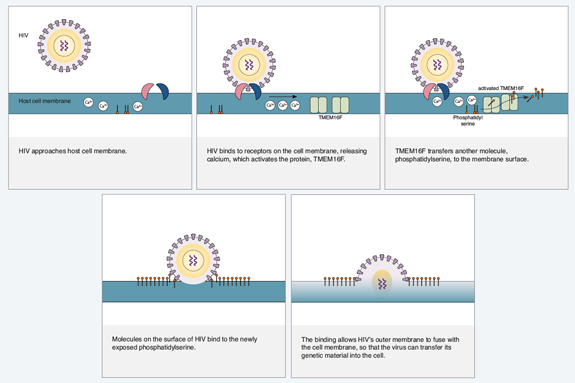NIH discovery could lead to new drugs to prevent HIV infection

WHAT:
Researchers at the National Institutes of Health have discovered a key step in the process that HIV uses to inject its genetic material into cells. Working with cultures of cells and tissues, the researchers prevented the invasion process by chemically blocking this step, preventing HIV genetic material from entering cells. The findings could lead to the eventual development of new drugs to prevent HIV infection.
The study, appearing in Cell Host & Microbe, was led by Leonid V. Chernomordik, Ph.D., at NIH’s Eunice Kennedy Shriver National Institute of Child Health and Human Development (NICHD).
To infect a cell, a protein on the surface of HIV binds to molecules on the cell’s surface. This binding process initiates a sequence of events that ends with HIV’s outer membrane fusing with the cell’s membrane. The virus’ genetic material then passes into the cell. The researchers discovered that the binding process activates a protein, called TMEM 16F, that transfers another molecule inside the cell membrane, phosphatidylserine, to the membrane’s outer surface. They believe molecules in the viral membrane bind with the exposed phosphatidylserine on the cell surface to enhance the virus’ fusion to the cell.
The researchers found that blocking the transfer of phosphatidylserine to the cell surface—or attaching another molecule to phosphatidylserine so it can’t bind with HIV—prevents the virus from infecting the cell. Theoretically, developing drugs that could block each of these steps could provide the basis for treatments to prevent HIV from infecting cells, but much more research is needed.
WHO:
Leonid Chernomordik, Ph.D., study author and senior investigator in the NICHD Section on Membrane Biology, is available for comment.
ARTICLE:
Zaitseva E. et al. Fusion stage of HIV-1 entry depends on virus induced cell surface exposure of phosphatidyl serine. Cell Host & Microbe 2017.
###
About the Eunice Kennedy Shriver National Institute of Child Health and Human Development (NICHD): NICHD conducts and supports research in the United States and throughout the world on fetal, infant and child development; maternal, child and family health; reproductive biology and population issues; and medical rehabilitation. For more information, visit NICHD’s website.
About the National Institutes of Health (NIH): NIH, the nation's medical research agency, includes 27 Institutes and Centers and is a component of the U.S. Department of Health and Human Services. NIH is the primary federal agency conducting and supporting basic, clinical, and translational medical research, and is investigating the causes, treatments, and cures for both common and rare diseases. For more information about NIH and its programs, visit http://www.nih.gov.

 BACK TO TOP
BACK TO TOP